Augmenting Ourselves to Death
The wisdom that the technological critics of the twentieth century have to offer us
Thank you for being here. As always, these essays are free and publicly available without a paywall. If my writing is valuable to you, please share it with a friend or support me with a paid subscription.
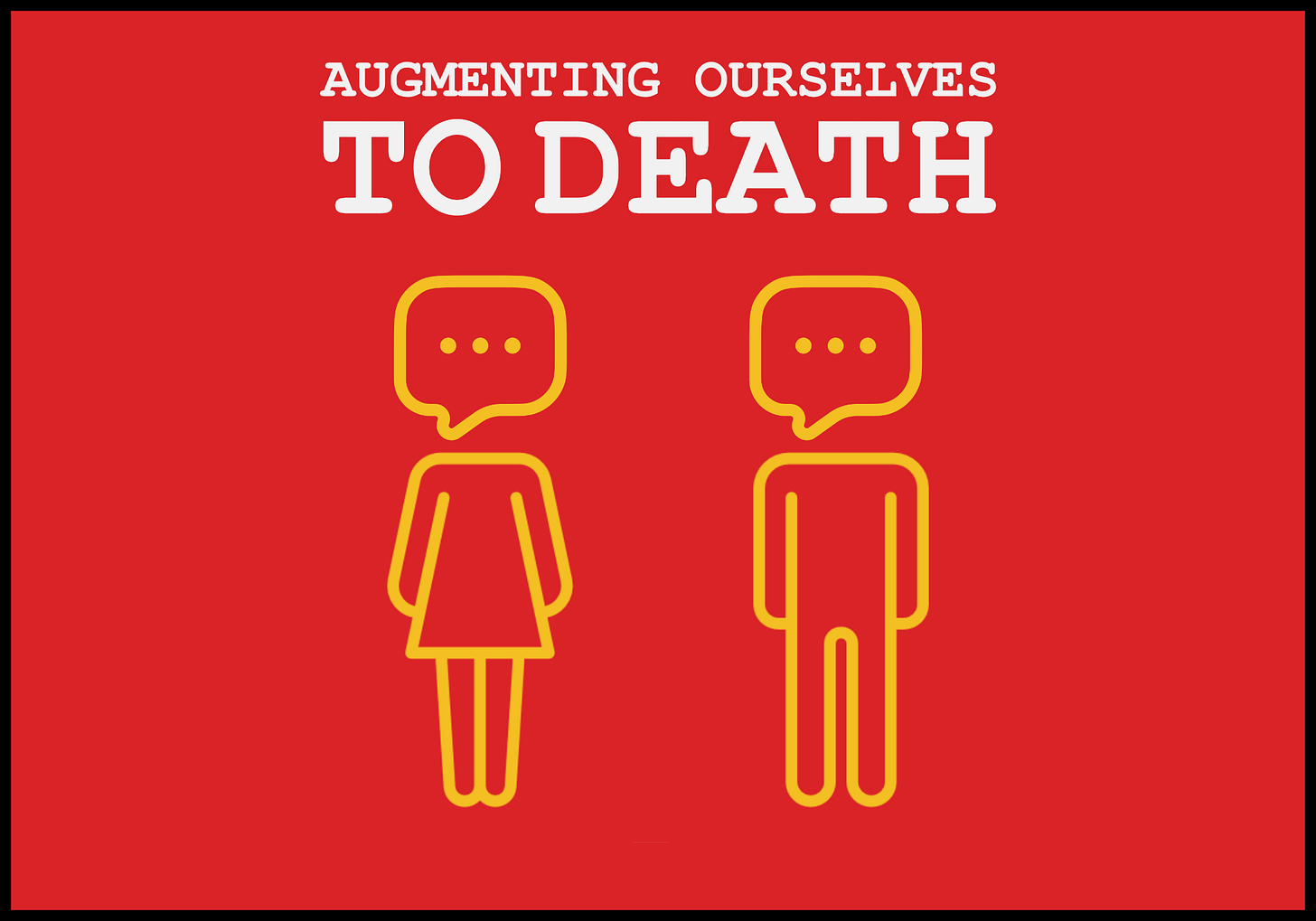
“The web of technology can indeed be woven differently, but even to discuss such intentional changes of pattern requires an examination of the features of the current pattern and an understanding of the origins and the purpose of the present design.”
Ursula Franklin in The Real World of Technology
Surely I am in good company when I say that the last half a decade as an educator has been a roller coaster. Just six months after I started my faculty position at Harvey Mudd, the world slowed to a halt as we grappled with the COVID-19 pandemic. Then, just as things began to return to a new normal and the regular rhythms of campus started to reestablish themselves in 2022, OpenAI released the first widely-publicized, productized interface to the newest innovation in AI: the large language model (LLM).
In the last several years, the conversation in education has evolved along several different trajectories, ranging from wild optimism about how AI will revolutionize the way we learn to handwringing concern about how LLMs can undermine the entire educational enterprise. It’s no surprise that educators are scrambling for answers to big, often existential, questions.
In the midst of the chaos, we’ve all been looking for concrete ideas to hold on to. In the midst of a storm, you need a strong anchor. But unfortunately, many of us have left our most trustworthy anchors off the boat. Instead, we’ve got weak substitutes—proxies that help us shed some weight as we do our best to cope with the many pressures pushing on us from all sides. The pressures are not in short supply. Educators are increasingly asked to do more with the same resources, students are overloaded with the expectations of their parents and an ever-growing list of extracurricular demands, and parents are increasingly concerned about preparing their kids to thrive in an uncertain economy and a dramatically changing future.
What you need in a storm is a guide. A light in the darkness that will help us to find our bearings.
An unexpected source of hope
The greatest balm I have found in the past few years, perhaps counterintuitively, has been the technological critics of the 20th Century. None of these thinkers—folks like Ursula Franklin, Jacques Ellul, Ivan Illich, Neil Postman, Marshall McLuhan, and C.S. Lewis—directly addressed artificial intelligence or the challenges that LLMs offer us in the modern educational project. Furthermore, none of them had a particularly cheery outlook for how technology was shaping our world. But despite their general pessimism and lack of specific policy suggestions for how to address AI, I find glimmers of hope in the wisdom that they impart.
As I wrote a few weeks ago, the most accurate mental model for how we move forward into the future is with our backs turned toward it. While we might wish that we had the clear-eyed prescience of science fiction, the truth is that the future is much murkier, riddled with unknowns. Recognizing that we are walking backward into the future suggests that we ought to be humble as we seek to find our way forward, mindful of the pitfalls and unknown terrain at our heels.
While this posture puts us at a disadvantage for moving into the future with confidence, it does offer us something else: the opportunity to attend to the past and the wisdom present there. Despite the novelty of generative artificial intelligence, past technological innovations offer us plenty of guidance on how we might approach these new challenges.
This is where the technological critics of the 20th century can be our guides. They offer us two tools: a lens and a mirror. The lens pulls into focus lessons from the past. The mirror helps us to see, albeit dimly, a path forward into the uncertain future that lies behind us.
If you've been reading me for any amount of time, my gratitude for these thinkers will come as no surprise. I've written about Ursula Franklin and her concept of prescriptive and holistic technologies, Marshall McLuhan's provocative assertion that "the medium is the message," Jacques Ellul's critique of technique as a totalizing force which dominates the impact of the individual tools that exist as part of it, and Ivan Illich's description of tools for conviviality and why generative AI falls short.
Today, my goal is synthesis. I want to take a step back and look at these thinkers not in isolation, but in conversation with each other. To see the ways that the threads they each pull on are part of a larger tapestry, a cohesive narrative about the nature of technology and its opportunities and threats. My hope is that in seeing the past more clearly through their insights, we might find anchors to hold on to in the days ahead.
To be sure, this is only a start. I've wondered recently whether there might be a book to be written out of this idea: a sampler of sorts to highlight these voices for the builders of today. Perhaps I will one day write that book. But for today, I want to take a shot at the big picture.
In the paragraphs that follow, I’ll briefly summarize a big idea that I’ve learned from these thinkers with a short reflection on what it might mean for how we might respond. My hope is that these ideas might pique your curiosity, as they have mine, and encourage you to dig more deeply into the wisdom and challenge that they have to offer us.
Prescriptive vs. Holistic Technologies: Are our tools giving us more or less control over the work?
It is the first kind of specialization, by product, that I call holistic technology, and it is important because it leaves the doer in total control of the process. The opposite is specialization by process; this I call prescriptive technology. It is based on a quite different division of labour. Here, the making or doing of something is broken down into clearly identifiable steps. Each step is carried out by a separate worker, or group of workers, who need to be familiar only with the skills of performing that one step. This is what is normally meant by “division of labour”
Ursula Franklin in The Real World of Technology
When Franklin writes about prescriptive vs. holistic technologies, she is writing about the craftsman vs. the assembly line worker. Holistic technology sees a single artist in control of the entire creative process, weaving together the individual pieces into a coherent whole. Prescriptive technology, on the other hand, breaks a task down into its constitutive parts, farming them out via a division of labor without visibility between the individual tasks.
One could make a case that LLMs can be used in either of these ways. On the one hand, they allow a single individual to accomplish their work in a more holistic manner than previously possible by providing access to information that would have been much more difficult to access otherwise. With LLM-assistance, it is possible to create computer programs without knowing how to code. It’s possible to generate step-by-step instructions in nearly any domain of human activity without any prior exposure to the subject matter simply by asking a question and exploring a particular part of the LLM’s parameter space.
And yet, LLMs can lend themselves even more strongly to a prescriptive mode, further relegating human expertise to a narrow lane where the AI tools are not yet able to produce the needed output with enough fidelity. If we’re not mindful of the way we are using LLMs, they may end up using us. Instead of humans controlling the process, we can become increasingly controlled by it, losing our ability to think clearly about the task at hand and how we ought to approach it.
Technique: Have the means become the ends?
The term technique, as I use it, does not mean machines, technology, or this or that procedure for attaining an end. In our technological society, technique is the totality of methods rationally arrived at and having absolute efficiency (for a given stage of development) in every field of human activity.
Jacques Ellul in The Technological Society
Jacques Ellul is hard to parse. Probably at least in part due to the fact that we read his work in English as translated from the original French. The block quote above is a good example. If you read that and still don’t quite understand what he means by “technique,” fear not, you are in good company.
When Ellul writes about technique, he is writing about technology at a level of abstraction that is more general than any one tool or technology. What he is writing about is the system that is created and sustained by individual tools.
In many ways, what he is calling our attention to is the way that technology shapes the way we see the world. It is not hard to see what he’s talking about. What he calls out in this particular passage is the way that technology naturally reshapes the way we think about ends and means. When we build a new technology, we become concerned with how it performs. We want to know how to assess its performance along some axis and to develop quantitative measures of its usefulness to us. If you’ve ever met an engineer, you know this. We want to know how powerful, how efficient, how costly, how durable. These are all important questions and aspects of our tools that we should be concerned with.
But when we focus too intently on these specifications, it is easy to lose track of the purpose for which we care about them in the first place. Why exactly do we care how powerful our machine is or how much it costs? Efficiency is fine and good, but efficiency is a way to characterize a process, not a way to evaluate its product. Obsession with efficiency is a surefire way to lose the forest for the trees. Creating something efficiently is only worth anything if that thing is worth creating in the first place.
In Ellul’s writing, he is drawing our attention to this dilemma. It is one that we can easily miss, since it lives at a level of abstraction above any individual technology we develop. It is a pernicious mindset that creeps into our thinking, and if we are careful, we will turn the means into ends, thereby losing our ability to orient ourselves toward the reason we are doing it in the first place.
Anti-convivial tools: Are the machines working for us, or are we working for the machines?
For a hundred years we have tried to make machines work for men and to school men for life in their service. Now it turns out that machines do not “work” and that people cannot be schooled for a life at the service of machines. The hypothesis on which the experiment was built must now be discarded. The hypothesis was that machines can replace slaves. The evidence shows that, used for this purpose, machines enslave men. Neither a dictatorial proletariat nor a leisure mass can escape the dominion of constantly expanding industrial tools.
The crisis can be solved only if we learn to invert the present deep structure of tools; if we give people tools that guarantee their right to work with high, independent efficiency, thus simultaneously eliminating the need for either slaves or masters and enhancing each person’s range of freedom. People need new tools to work with rather than tools that “work” for them. They need technology to make the most of the energy and imagination each has, rather than more well-programmed energy slaves.
Ivan Illich in Tools for Conviviality
There is something about the framing of AI “agents” that makes me uncomfortable. Much like the AI “companions” that should similarly make us think twice, the desire for AI agents smells of a certain kind of desire to master something or someone, to be in charge of someone else who will do our bidding. There is more than a whiff of a desire for power and control that will point us toward vice instead of virtue.
Beneath the surface, I sense a disdain for work and an idolization of freedom from it. In our modern world, we seem to have lost the plot. We have lost an appreciation for the goodness of work and rest. Instead, we see work as toil and crave leisure instead of rest. These are cheap substitutes.
To be sure, there is a sense in which our work often does feel like toil. When it is framed as toil, a sort of pointless labor that is worthwhile only for the product that it produces rather than the effort that brings that product into existence, of course, we would want our work to be outsourced. If the product is all that matters, who cares how we get there?
Although he is very much focused on the lack of convivial tools, Illich reminds us that convivial tools can help us shape our world for the better. A good tool makes the work even more worth doing. It aligns us with the intrinsic value of the process, helping to redeem and reshape what could otherwise be toil into labor that is meaningful and rich, even as it may still require our attention and sweat.
Convivial tools are those which give each person who uses them the greatest opportunity to enrich the environment with the fruits of his or her vision. Industrial tools deny this possibility to those who use them and they allow their designers to determine the meaning and expectations of others. Most tools today cannot be used in a convivial fashion.
Ivan Illich in Tools for Convivality
What we should consider is whether the tools we are creating are giving us, as Illich puts it, the greatest opportunity to enrich the environment with the fruits of our vision. These must be tools that are designed to give us the freedom as individuals to define the ends to which they are directed, not overly constrained tools designed to serve the interests of their creators.
The Medium is the Message: How are our technologies changing our ecosystem?
Any invention or technology is an extension or self-amputation of our physical bodies, and such extension also demands new ratios or new equilibriums among the other organs and extensions of the body.
Marshall McLuhan in Understanding Media
McLuhan's magnum opus, Understanding Media, takes us on a whirlwind tour, unpacking how everything from language, roads, clocks, print, housing, the wheel, games, the telephone, television, the radio, weapons, and more shapes the world we see through them.
His central point is that tools are not neutral conduits for information flow. Although they are in one sense morally neutral since they do not have agency on their own, their design prejudices them toward particular uses. The chat-style interface invites the temptation to assume there is another person sending replies. The subtle progressive "typing" behavior of the chatbot responses as the continuation tokens are generated makes it seem like someone is hammering out a reply rather than an algorithm solving for successive probabilities. The message that GPT-5 "thought" for 33 seconds before returning the computed result, along with a transcript of messages that the LLM sent to itself, gives the impression of thinking and reasoning when no such thing is actually happening.
I could go on, but you get the point. To understand that the medium is the message is to recognize that to approach a problem with an LLM is to condition oneself to a particular kind of solution.
To the one holding a hammer, everything looks like a nail. To the one holding an LLM...
Men without Chests: How do our new inventions eliminate the potential for the world that we most need?
C. S. Lewis, in many ways, is the outlier in this group. He is not often considered to be in the same category as these other writers who focused more specifically on the impact of technology. But if you read him in The Abolition of Man, you will find that what he has to say is quite relevant to our technological moment. He writes:
And all the time—such is the tragi-comedy of our situation—we continue to clamour for those very qualities we are rendering impossible. You can hardly open a periodical without coming across the statement that what our civilization needs is more 'drive', or dynamism, or self-sacrifice, or 'creativity'. In a sort of ghastly simplicity, we remove the organ and demand the function. We make men without chests and expect of them virtue and enterprise. We laugh at honour and are shocked to find traitors in our midst. We castrate and bid the geldings be fruitful.
C. S. Lewis in The Abolition of Man
In a world where technology is increasingly shaping the tenor of our lives, both individually and together, we should ask ourselves not just what our technology is enabling, but what it is "rendering impossible".
Perhaps the reality is that rather than removing the organ, we are augmenting it in such a way that it cannot function as we need it to either.
As we search for a path forward, there are no clear answers. But what these thinkers provide for us is a set of questions that can help to guide us in the days ahead:
How are our tools reshaping the way that we do our work?
How have the means become the ends?
Are our machines working for us, or are we working for our machines?
How are the tools we use reshaping the way that we see the world around us?
In our fervor to create ever more powerful tools, are we augmenting ourselves to death?
As we contemplate our work, whether that be in education or otherwise, these are a set of questions that will simultaneously illuminate the past and provide us with a way to walk with humility into the future. They will equip us, not with a set of ironclad "solutions" (as if such a thing actually exists at all), but rather with a lens and a mirror that will help us to see the past clearly and walk backward into the future with wisdom.
Got a thought? Leave a comment below.
If you liked this essay, consider emailing it to a friend, posting it somewhere else on the Internet, or restacking it here on Substack.
Reading Recommendations
A few weeks ago, my friend and Praxis colleague
recorded a conversation with about spiritual formation and AI. Andy is one of the most thoughtful people I know on the topic of the formative (and deformative) impact that technology can have on us. If you’re at all curious about how AI is shaping us as humans, I think you’ll find this conversation thought-provoking.Last week I sat down with
, host of the Everything Playbook podcast, to talk about all things AI, education, and character development.The Book Nook
The AI Mirror by Shannon Vallor continues to be an excellent read. If you haven’t picked it up yet, I highly recommend that you do!
The Professor Is In
Tomorrow is the day! It’s your last chance to register for the talk I’ll be giving for the MIT Teaching + Learning Lab on generative AI through the lens of the technological critics of the twentieth century at 9 am PT / 12 pm ET.
As you might imagine, this post is riffing on some of the themes that I’ll pull on. In the talk, we’ll turn the corner toward some more prescriptive thoughts about what these questions might mean for us in educational spaces. I hope to see you there!
Last week, Prof. Rao Kambhampati from Arizona State University visited Harvey Mudd to give the first CS Colloquium talk of the year. With the provocative title “(How) Do LLMs Reason?”, Rao explained (pretty convincingly) why the self-talking “reasoning traces” that are part and parcel of large reasoning models like GPT-4o aren’t really all they’re cracked up to be. Slides here.
Leisure Line
I’m not sure who needs to hear this, but this Evapo-Rust stuff works like gangbusters. I got it to revitalize a few parts on my bikes, and after letting them soak in this stuff overnight, you’d never know they were rusty to begin with. h/t to this YouTube video from Adam Savage (of Mythbusters fame) for turning me on to this stuff.
Also, pretty cool to see my e-bike on kottke.org last week.
Still Life
#1 and I went to the Claremont HS football game last Friday night. Fun atmosphere and a perfect California night for it.


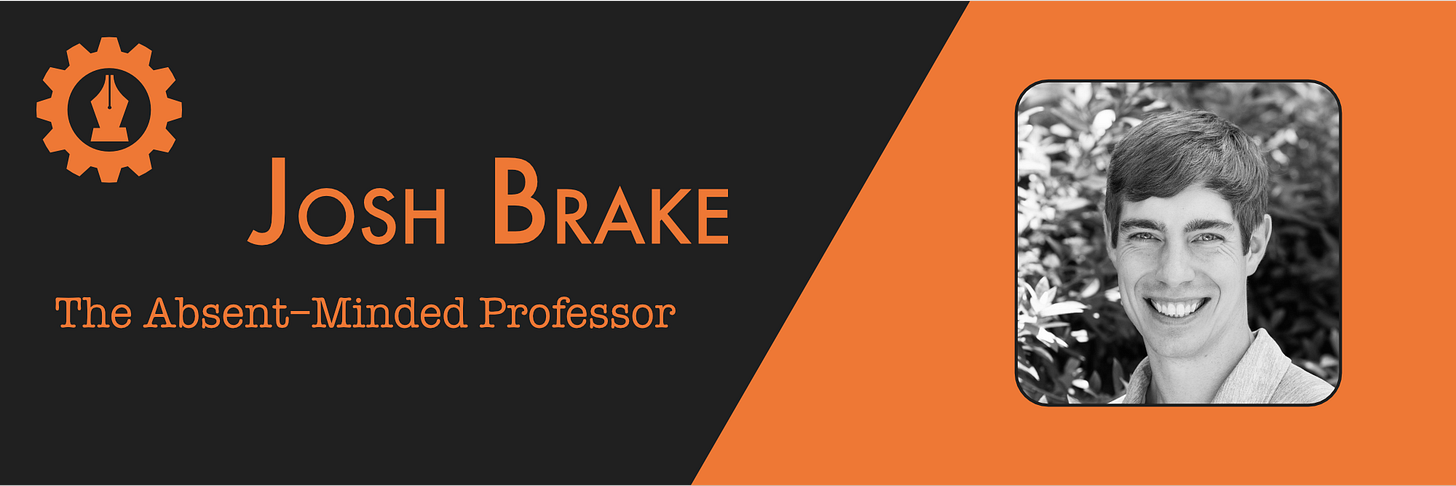

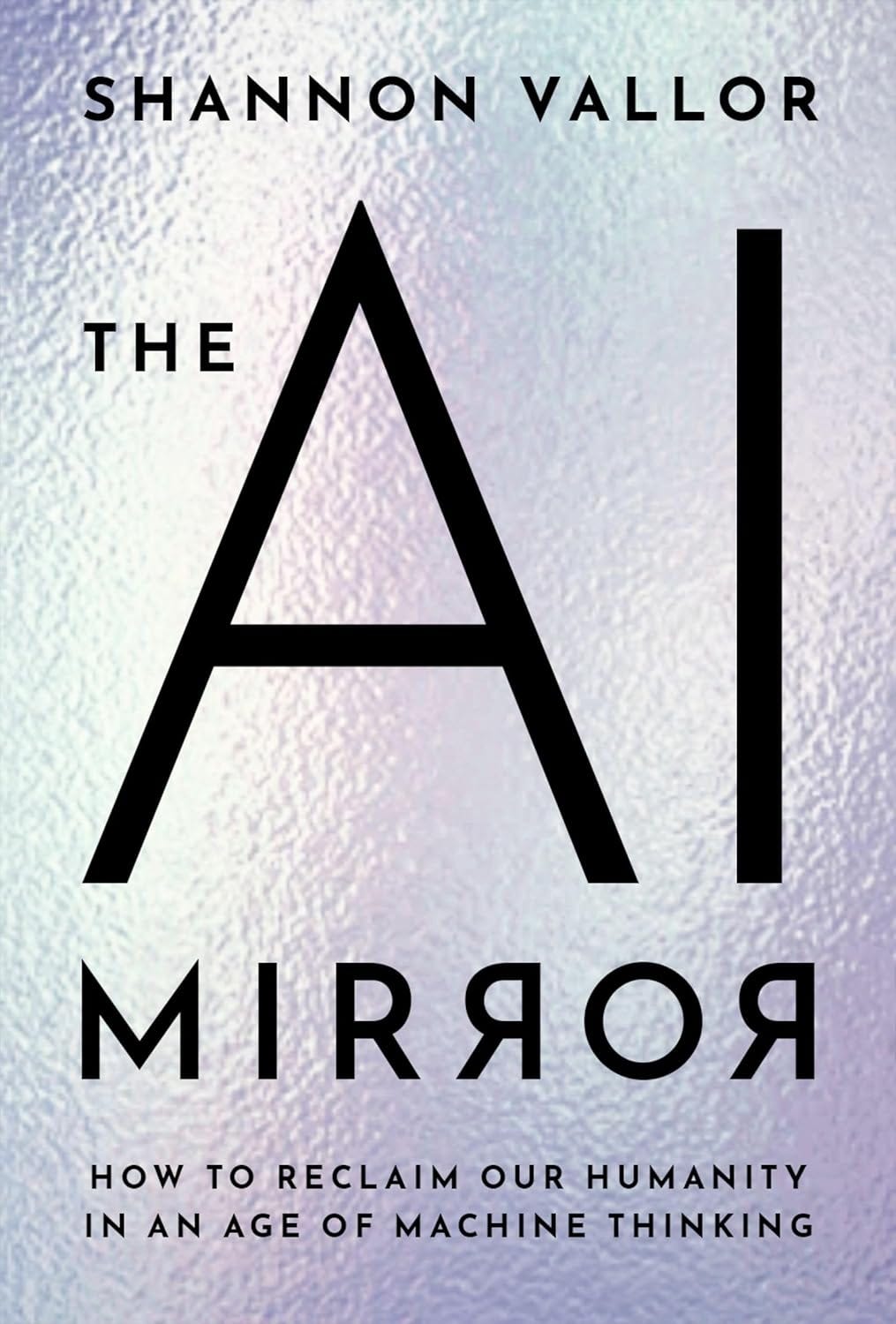
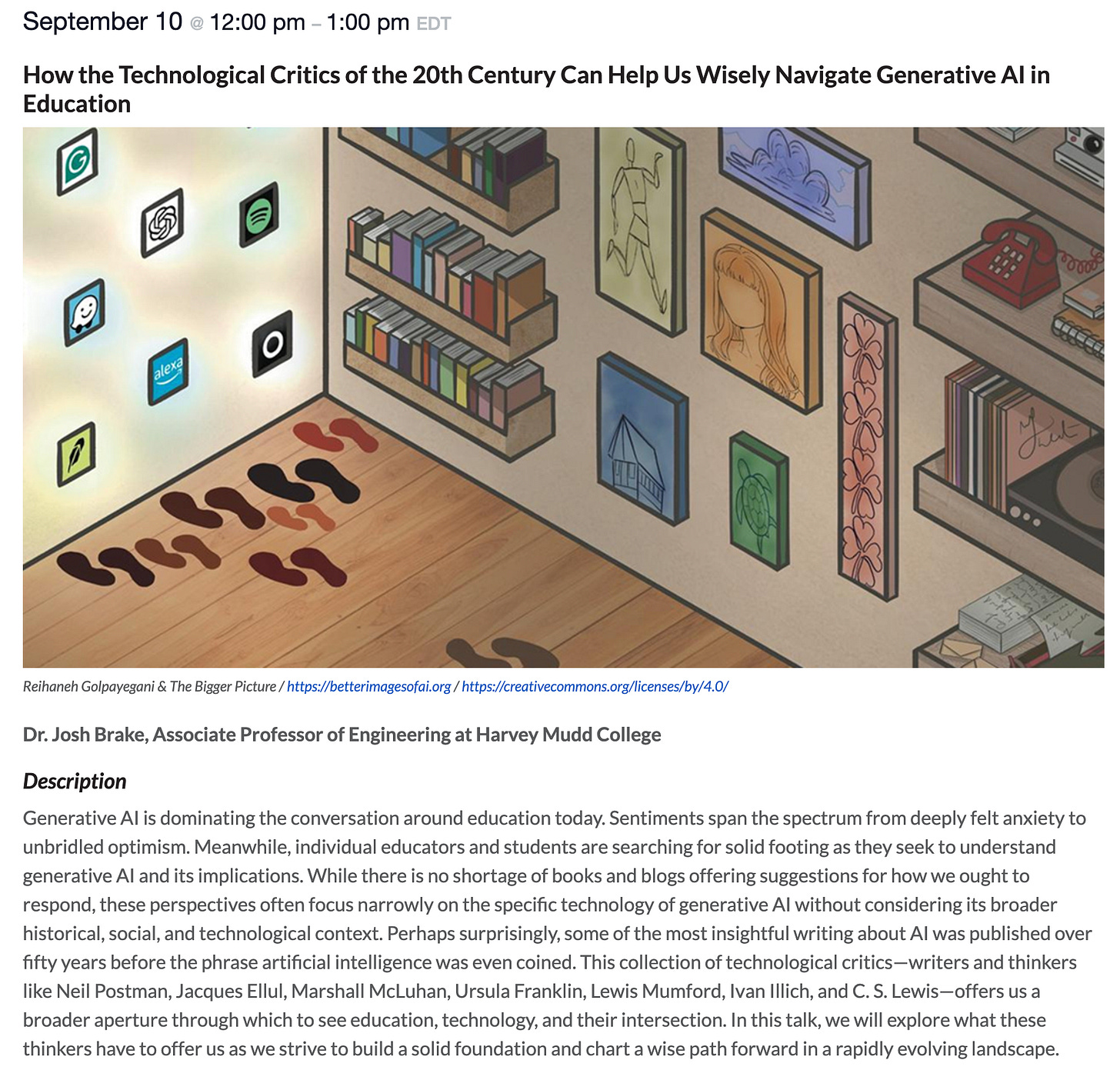
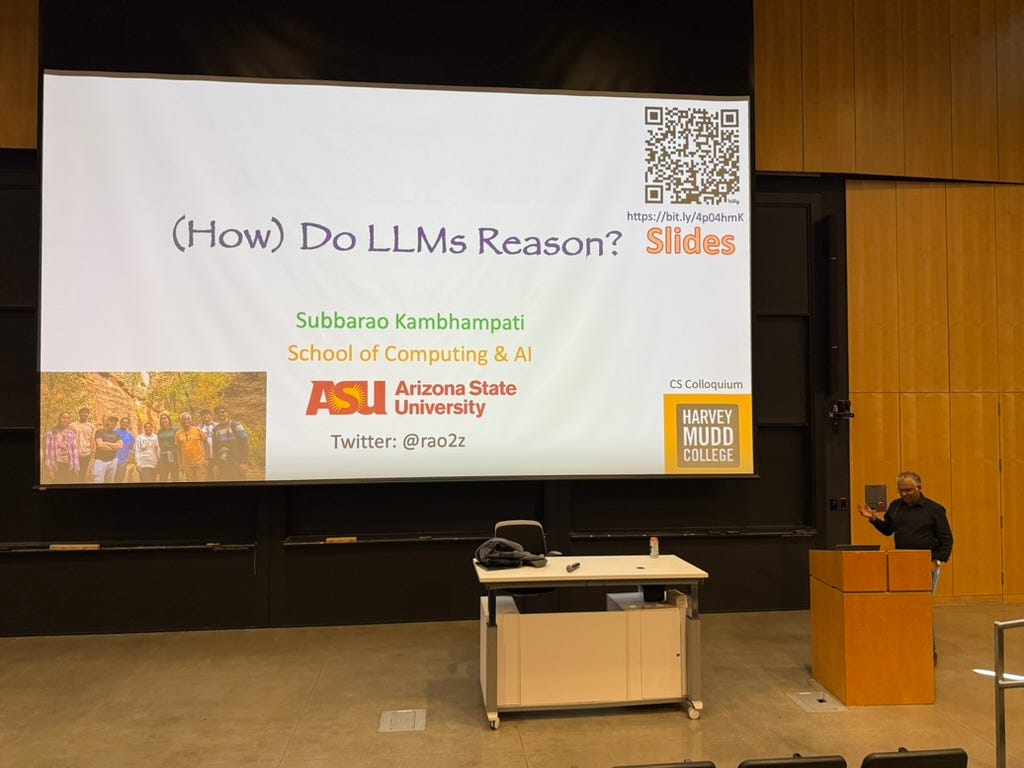


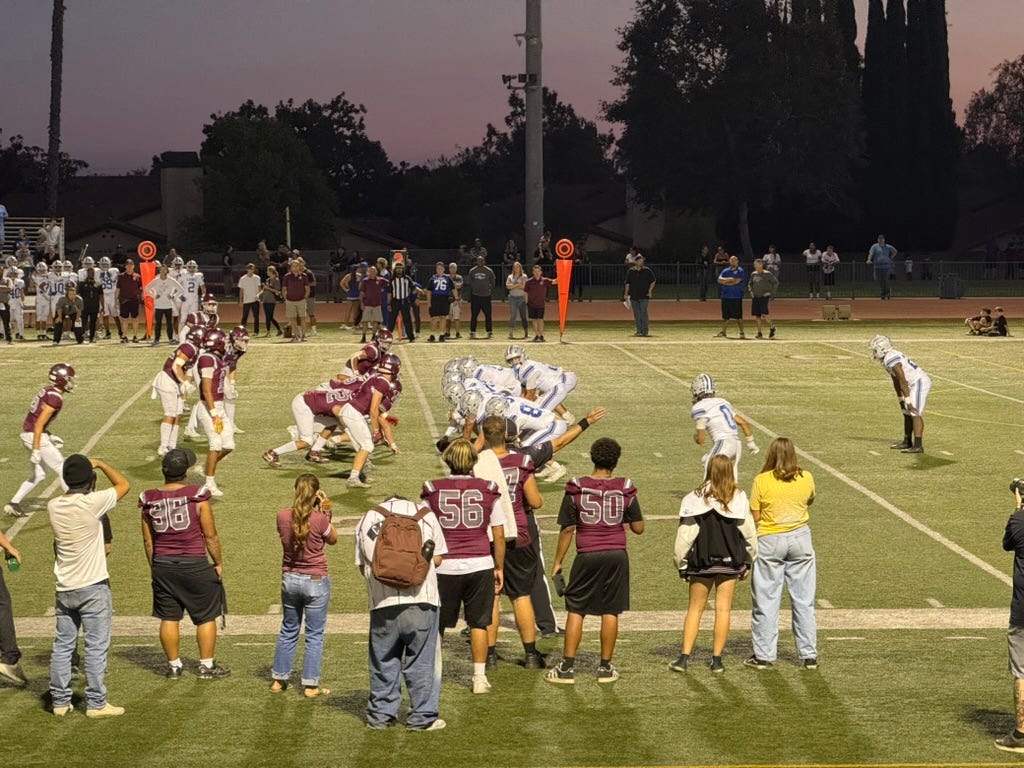
Loved your article! I keep asking Illich’s question: Does this tool expand my agency or someone else’s? When I answer “mine and my students’,” LLMs help me publish guides, design scaffolds, and show up more for my community.
Not that I "heart" the need for this content, more that I appreciate your approach, analysis, and sources. TY - great work.